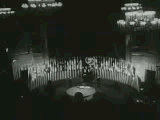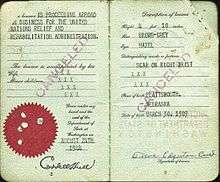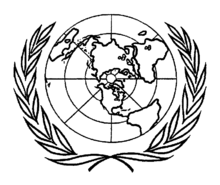History of the United Nations

The history of the United Nations as an international organization has its origins in World War II. Since then its aims and activities have expanded to make it the archetypal international body in the early 21st century.
Origins
The earliest concrete plan for a new world organization to replace the ineffective League of Nations began under the aegis of the US State Department in 1939.[1] On 12 June 1941, representatives of the United Kingdom, Canada, Australia, New Zealand, the Union of South Africa, and of the exiled governments of Belgium, Czechoslovakia, Greece, Luxembourg, Netherlands, Norway, Poland, and Yugoslavia, as well as General de Gaulle of France, met in London and signed the Declaration of St. James's Palace. This was the first of six conferences that led up to the founding of the United Nations and the Charter of the United Nations.[2]
U.S. President Franklin Roosevelt first suggested using the name United Nations, to refer to the Allies of World War II, to British Prime Minister Winston Churchill during the latter's three-week visit to the White House in December 1941. Roosevelt suggested the name as an alternative to "Associated Powers", a term the U.S. used in the First World War (the U.S. was never formally a member of the Allies of World War I but entered the war in 1917 as a self-styled "Associated Power"). Churchill accepted the idea and cited Lord Byron's use of the phrase "United Nations" in the poem Childe Harold's Pilgrimage, which referred to the Allies at the Battle of Waterloo in 1815.[3][4]
1942 "Declaration of United Nations"
The text of the "Declaration by United Nations" was drafted by U.S. President Franklin D. Roosevelt, British Prime Minister Winston Churchill, and Roosevelt aide Harry Hopkins, while meeting at the White House on 29 December 1941. It incorporated Soviet suggestions, but left no role for France. The first official use of the term "United Nations" was on 1–2 January 1942 when 26 Governments signed the Declaration. One major change from the Atlantic Charter was the addition of a provision for religious freedom, which Stalin approved after Roosevelt insisted.[5][6] By early 1945 it had been signed by 21 more states.[7]
A JOINT DECLARATION BY THE UNITED STATES OF AMERICA, THE UNITED KINGDOM OF GREAT BRITAIN AND NORTHERN IRELAND, THE UNION OF SOVIET SOCIALIST REPUBLICS, CHINA, AUSTRALIA, BELGIUM, CANADA, COSTA RICA, CUBA, CZECHOSLOVAKIA, DOMINICAN REPUBLIC, EL SALVADOR, GREECE, GUATEMALA, HAITI, HONDURAS, INDIA, LUXEMBOURG, NETHERLANDS, NEW ZEALAND, NICARAGUA, NORWAY, PANAMA, POLAND, SOUTH AFRICA, YUGOSLAVIA
The Governments signatory hereto,
Having subscribed to a common program of purposes and principles embodied in the Joint Declaration of the President of the United States of America and the Prime Minister of Great Britain dated August 14, 1941, known as the Atlantic Charter,
Being convinced that complete victory over their enemies is essential to defend life, liberty, independence and religious freedom, and to preserve human rights and justice in their own lands as well as in other lands, and that they are now engaged in a common struggle against savage and brutal forces seeking to subjugate the world,
DECLARE:
(1) Each Government pledges itself to employ its full resources, military or economic, against those members of the Tripartite Pact and its adherents with which such government is at war.
(2) Each Government pledges itself to cooperate with the Governments signatory hereto and not to make a separate armistice or peace with the enemies.
The foregoing declaration may be adhered to by other nations which are, or which may be, rendering material assistance and contributions in the struggle for victory over Hitlerism.[8]
During the war, the United Nations became the official term for the Allies. To join countries had to sign the Declaration and declare war on the Axis.[9]
Planning

The idea for the future United Nations as an international organization emerged in declarations signed at the wartime Allied conferences: the Moscow Conference and the Tehran Conference in 1943.
From August to October 1944, representatives of the Republic of China, Britain, the US and the USSR met to elaborate plans at the Dumbarton Oaks Conference in Washington, D.C. Those and later talks produced proposals outlining the purposes of the United Nations organization, its membership and organs, as well as arrangements to maintain international peace and security and international economic and social cooperation. Governments and private citizens worldwide discussed and debated these proposals.[10] Winston Churchill urged Roosevelt to restore France to its status of a major Power after the liberation of Paris in August 1944.
At the Yalta Conference it was agreed that membership would be open to nations that had joined the Allies by 1 March 1945.[11] Brazil, Syria and a number of other countries qualified for membership by declarations of war on either Germany or Japan in the first three months of 1945 – in some cases retroactively.
Establishment


On April 25, 1945, the United Nations Conference on International Organization began in San Francisco. In addition to Governments, a number of non-government organizations, including Rotary International and Lions Clubs International received invitations to assist in the drafting of a charter. After working for two months, the fifty nations represented at the conference signed the Charter of the United Nations on 26 June. Poland, which was unable to send a representative to the conference due to political instability, signed the charter on 15 October 1945. The charter stated that before it would come into effect, it must be ratified by the Governments of the Republic of China, France, the USSR, the United Kingdom, and the United States, and by a majority of the other 46 signatories. This occurred on 24 October 1945, and the United Nations was officially formed.[12]
The date each founding member state deposited their ratification of the UN Charter is as follows:[13]
- USA – 8 Aug 1945
- France – 31 Aug 1945
- Dominican Rep. – 4 Sep 1945
- Nicaragua – 6 Sep 1945
- New Zealand – 19 Sep 1945
- Brazil – 21 Sep 1945
- Argentina – 24 Sep 1945
- El Salvador – 26 Sep 1945
- Haiti – 27 Sep 1945
- China – 28 Sep 1945
- Turkey – 28 Sep 1945
- Denmark – 9 October 1945
- Chile – 11 Oct 1945
- Philippines – 11 Oct 1945
- Paraguay – 12 Oct 1945
- Cuba – 15 Oct 1945
- Lebanon – 15 Oct 1945
- Iran – 16 Oct 1945
- Luxembourg – 17 Oct 1945
- Saudi Arabia – 18 Oct 1945
- Czechoslovakia – 19 Oct 1945
- Syria – 19 Oct 1945
- Yugoslavia – 19 Oct 1945
- UK – 20 Oct 1945
- Egypt – 22 Oct 1945
- Byelorussia – 24 Oct 1945
- Poland – 24 Oct 1945
- Ukraine – 24 Oct 1945
- USSR – 24 Oct 1945 (note - the United Nations is established on this date)
- Greece – 25 Oct 1945
- India – 30 Oct 1945
- Peru – 31 Oct 1945
- Australia – 1 Nov 1945
- Costa Rica – 2 Nov 1945
- Liberia – 2 Nov 1945
- Colombia – 5 Nov 1945
- Mexico – 7 Nov 1945
- South Africa – 7 Nov 1945
- Canada – 9 Nov 1945
- Ethiopia – 13 Nov 1945
- Panama – 13 Nov 1945
- Bolivia – 14 Nov 1945
- Venezuela – 15 Nov 1945
- Honduras – 17 Nov 1945
- Guatemala – 21 Nov 1945
- Norway – 27 Nov 1945
- Netherlands – 10 Dec 1945
- Uruguay – 18 Dec 1945
- Ecuador – 21 Dec 1945
- Iraq – 21 Dec 1945
- Belgium – 27 Dec 1945
The first meeting of the General Assembly was held in Westminster Central Hall, London, on 10 January 1946.[14] The Security Council met for the first time a week later in Church House, Westminster.[15] The League of Nations formally dissolved itself on 18 April 1946 and transferred its mission to the United Nations.
Activities
The United Nations has achieved considerable prominence in the social arena, fostering human rights, economic development, decolonization, health and education, for example, and interesting itself in refugees and trade.
The leaders of the UN had high hopes that it would act to prevent conflicts between nations and make future wars impossible. Those hopes have obviously not fully come to pass. From about 1947 until 1991 the division of the world into hostile camps during the Cold War made agreement on peacekeeping matters extremely difficult. Following the end of the Cold War, renewed calls arose for the UN to become the agency for achieving world peace and co-operation, as several dozen active military conflicts continued to rage across the globe. The breakup of the Soviet Union has also left the United States in a unique position of global dominance, creating a variety of new problems for the UN (See the United States and the United Nations).
Facilities


In December 1945, the US Senate and the US House of Representatives, by unanimous votes, requested that the UN make its headquarters in the United States. The UN accepted this suggestion and, after considering sites in the Black Hills, Flushing Meadows–Corona Park, Navy Island and what would become the World Trade Center site, constructed the United Nations headquarters building in New York City in 1949 and 1950 beside the East River on land purchased with an $8.5 million donation from John D. Rockefeller, Jr. The UN headquarters officially opened on January 9, 1951, although construction was not formally completed until October 9, 1952.[16]
Under special agreement with the United States, the UN enjoys certain diplomatic privileges and immunities, but generally the laws of New York City, New York State, and the United States apply.
While the principal headquarters of the UN remain in New York City, major agencies base themselves in Geneva, The Hague, Vienna, Nairobi and elsewhere.
Structure and associated organizations
The basic constitutional makeup of the United Nations has changed little, though vastly increased membership has altered the functioning of some elements. The UN as a whole has generated a rich assortment of non-governmental organizations and special bodies over the years: some with a regional focus, some specific to the various peacekeeping missions, and others of global scope and importance. Other bodies (such as the International Labour Organization) formed prior to the establishment of the United Nations and only subsequently became associated with it.
Milestones
- In October 2015 over 350 landmarks in 60 countries were lit in blue to commemorate the 70th anniversary of the world body.[17][18][19]
See also
- Growth in United Nations membership
- List of members of the United Nations Security Council
- Timeline of UN peacekeeping missions
- List of UN Secretaries-General
- Attacks on humanitarian workers
- Reform of the United Nations
Further reading
- Baehr, Peter R., and Leon Gordenker. The United Nations in the 1990s (St. Martin's Press, 1992)
- Bellamy, Alex J., and Paul D. Williams, eds. Providing Peacekeepers: The Politics, Challenges, and Future of United Nations Peacekeeping Contributions (Oxford University Press, 2013)
- Bergesen, Helge Ole, and Leiv Lunde. Dinosaurs or Dynamos: the United Nations and the World Bank at the turn of the century (Routledge, 2013)
- Bosco, David L. Five to rule them all: the UN Security Council and the making of the modern world (Oxford University Press, 2009)
- Clark, Ian, and Christian Reus-Smit. "Liberal internationalism, the practice of special responsibilities and evolving politics of the security council." International Politics (2013) 50#1 pp: 38-56.
- Ferdinand, Peter. "Rising powers at the UN: an analysis of the voting behaviour of brics in the General Assembly." Third World Quarterly (2014) 35#3 pp: 376-391.
- Hiscocks, Richard. The Security Council: A study in adolescence (Simon and Schuster, 1974)
- Luck, Edward C. UN Security Council: practice and promise (Routledge, 2006)
- Meisler, Stanley. United Nations: The First Fifty Years (1995)
- Rusell, Ruth B. A History of the United Nations Charter: The Role of the United Staes, 1940-1945 (Washington: Brookings Institution, 1958.)
- O'Sullivan, Christopher D. The United Nations: A Concise History (The Anvil Series, Krieger Publishing Company, 2005)
- Phillips, Walter Ray. "United Nations Educational, Scientific and Cultural Organization." Montana Law Review 24.1 (2014): 2.
- Roberts, Adam, and Dominik Zaum. Selective security: war and the United Nations Security Council since 1945 (Routledge, 2013)
- Saltford, John. The United Nations and the Indonesian takeover of West Papua, 1962-1969: the anatomy of betrayal (Routledge, 2013)
- Vreeland, James Raymond, and Axel Dreher. The Political Economy of the United Nations Security Council: Money and Influence (Cambridge University Press, 2014)
- Weiss, Thomas G. What's Wrong with the United Nations and how to Fix it (John Wiley & Sons, 2013)
- Wuthnow, Joel. Chinese diplomacy and the UN Security Council: beyond the veto (Routledge, 2012)
Primary sources
- Cordier, Andrew W., and Wilder Foote, eds. Public Papers of the Secretaries General of the United Nations (4 vol; Columbia University Press, 2013)
References
- ↑ Townsend Hoopes and Douglas Brinkley, FDR and the Creation of the U.N. (1997) pp 1-55
- ↑ "1941: The Declaration of St. James' Palace". United Nations. Retrieved 28 March 2016.
- ↑ "United Nations". Wordorigins.org. 3 February 2007. Retrieved 28 March 2016.
- ↑ Ward, Geoffrey C.; Burns, Ken (2014). "Nothing to Conceal". The Roosevelts: An Intimate History. Knopf Doubleday Publishing Group. ISBN 0385353065.
- ↑ David Roll, The Hopkins Touch: Harry Hopkins and the Forging of the Alliance to Defeat Hitler (2013) pp 172-75
- ↑ Robert E. Sherwood, Roosevelt and Hopkins, An Intimate History (1948) pp 447-53
- ↑ Edmund Jan Osmańczyk (2003). Encyclopedia of the United Nations and International Agreements: T to Z. Taylor & Francis. p. 2445.
- ↑ Text from "The Washington Conference 1941-1942"
- ↑ Stephen C. Schlesinger, Act of creation: The founding of the United Nations: A story of superpowers, secret agents, wartime allies and enemies, and their quest for a peaceful world (2003)
- ↑ http://www.un.org/en/aboutun/history/dumbarton_yalta.shtml
- ↑ Robert C. Hilderbrand, Dumbarton Oaks: The Origins of the United Nations and the Search for Postwar Security (UNC Press, 2001)
- ↑ http://www.un.org/aboutun/sanfrancisco/history.html The 60th Anniversary of the San Francisco Conference
- ↑ http://www.un.org/depts/dhl/unms/founders.shtml
- ↑ "History of the United Nations 1941 - 1950". United Nations. Retrieved 12 March 2015.
- ↑ "What is the Security Council?". United Nations. Retrieved 12 March 2015.
- ↑ http://select.nytimes.com/gst/abstract.html?res=F10813F7385E177B93C2A8178BD95F468585F9
- ↑ "World lights up in UN blue to mark Organization's milestone anniversary". UN News Centre. 22 October 2015. Retrieved 25 October 2015.
- ↑ "Over 200 Landmarks to Light Up UN Blue on 70th Anniversary". The New York Times. 23 October 2015. Retrieved 25 October 2015.
- ↑ "Turn the World #UNBlue". United Nations Information Centres. Retrieved 25 October 2015.
External links
- UN Intellectual History Project – Academic study of UN history
- United Nations Events Timeline
- Declaration by United Nations, January 1, 1942
- UN History Project – Website providing resources, timelines, lectures, and bibliographies of UN history